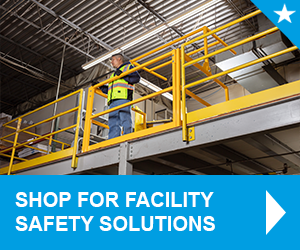
Every summer, heat dramatically increases the risk of exertion-related injuries. An analysis of OSHA-reported injuries between 2015 and 2022 found heat was related to 91.9% of all exertional injuries in the workplace – and exertion is far from the only heat-related hazard, especially in warehouse settings. Insufficient ventilation and heat-absorbent building materials, coupled with heat-induced dehydration or fatigue in employees, can further contribute to higher safety risks. For these and many other reasons, OSHA requirements for fall protection become all the more important during summer months.
We’ll explore how high temperatures increase the risks of falls, and how warehouse safety managers can proactively maintain a safe work environment during the hotter months.
How Summer Increases Fall Risks
By understanding how elevated temperatures contribute to higher fall risks, you’ll be better able to select the right protection devices according to a wider range of hazards. Depending on your warehouse and its operational workflows, any of the following could affect your workers during the summer:
- Heat-related bodily stress, leading to fatigue, dizziness, and dehydration
- Increased slip hazards, due to dripping sweat or equipment condensate
- Higher chance of glares and reduced visibility at inopportune moments
During summer, these issues particularly affect workers at height, as the heat increasingly affects a warehouse’s upper work areas. This is also usually a time of greater workloads, increasing warehouse safety concerns overall. When temperatures increase, small and enterprise-level warehouse owners alike should spare no expense in their fall protection efforts.
Achieving Greater Fall Protection in the Heat
While OSHA often grants multiple options to fulfill the same safety need, it’s best practice to select the most effective option whenever multiple safety risks are present (such as simultaneous heat and fall hazards).
At the end of the day, the only true measure of success is your own facility’s safe operation. As you source the best fall protection and other warehouse safety equipment, be sure it not only meets OSHA requirements for fall protection and other hazards but exceeds their minimum standards wherever possible.
Heat-Related Mezzanine Accidents
Mezzanines frequently appear in warehouses because they maximize vertical space, providing not only extra storage but also additional operating space without requiring building owners to expand the building’s physical footprint. As most mezzanines are metal, slip hazards and bright glares are more of a concern the hotter it gets. Any time lifting machinery is also involved, you further introduce risks associated with oil or condensate, not to mention the heavy equipment and loads themselves.
At any temporary break in mezzanine guardrails, install only the highest-quality and most user-friendly mezzanine gates. Risks of heat exhaustion become much more pronounced if workers must contend with cumbersome gate mechanisms or awkward designs. Poor gate design can cause workers to:
- Lose situational awareness
- Take their hands off loads more than strictly necessary
- Risk not securing the gate properly
A mezzanine gate is one of the most important types of warehouse safety gates, because fall hazards also involve heavy loads and equipment. Be sure your mezzanine gates are as easy to use as they are effective.
Increased Loading Dock Activity
Chances are that your warehouse shipments increase during the summer – meaning so too does your risk of loading dock accidents. Blurred vision is one of the first signs of heat exhaustion, and at a loading dock, you need a crystal-clear signal of when it’s safe to approach loading areas. It’s also important that any safety device keeping workers from prematurely approaching the dock’s edge doesn’t swing into adjacent work areas, trading one safety hazard for another.
Consider vertical-lift loading dock gates, which keep the gate safely out of harm’s way even when open and act as a failsafe signal of when it’s unsafe to approach the delivery bay. Be sure they’re yellow powder coated to ensure a lasting bright yellow signal that will catch a tired worker’s eye even at the end of a hot summer day shift.
Stairs and Other Elevated Entryways
All it takes is one bead of sweat to make an elevated entryway hazardous, especially at the end of a long, tiring shift. OSHA requirements for fall protection on stairways and ladders don’t always require gates, but they’re far superior to the alternatives. While guardrails or personal fall protection systems are also acceptable, the former alone is often insufficient, and the latter can be cumbersome.
That’s especially true for employees performing their work under high temperatures with both safely and efficiency in mind. On both counts, a warehouse safety gate saves time, and it saves workers from injuries. Depending on the circumstance, safety gates can open away from the stairway or ladder; but whenever safety gates open directly onto them, OSHA’s 1926.1052(a)(4) requires two things:
- The gate must open onto a platform
- The gate’s swing must not “reduce the effective width of the platform to less than 20 inches (50.8 cm).”
Note that on fixed-stair landings, 1917.120(b)(2) allows the platform’s effective width to be 18 inches (45.72 cm). For non-fixed stairways/ladderways, modular guardrail systems can greatly enhance efficiency without sacrificing safety.
For any application, a stair gate for warehouses requires a precise rail-to-rail or rail-to-wall fit. It could be the last form of protection for busy workers at risk of passing out, slipping, or otherwise losing control due to the heat. By making exhausted workers open a warehouse safety gate before descending stairways, you’re giving them a moment to collect themselves when it counts most.
Some warehouse and storage facilities find workarounds for such scenarios, but this is ineffective and dangerous. The only good solution to oddly spaced openings is to work with a fall protection company specializing in custom safety gates made to exact dimensions and specifications, including:
- Mount type, quantity, and direction (left or right)
- Latching systems
- Materials, coatings, and colors
- Door style (single gate vs. saloon)
Be sure any stair gate for warehouses fits the exact space it was intended for and consider any extra features that might not only boost safety but productivity as well. Self-closing gates are an excellent way to ensure employees can focus on the task at hand while keeping their eye on their surroundings. This is a requirement for floor access points (such as roof access ladders).
Double Down on Warehouse Fall Protection to Reduce Heat-Related Injuries
The right fall protection equipment can keep warehouse workers safe, even at heightened temperatures. By installing a warehouse safety gate built to the highest standards, workers won’t have multiple dangers to contend with during the hot summer months.
If you need help selecting the right mezzanine, loading dock, or stair gate for warehouses, Fabenco’s fall protection experts are standing by to assist you. With over 45 years of experience, we’ve increased the standards for fall protection safety equipment across numerous industries across the globe. Our extensive line of innovative safety gates supports the needs of warehouses, industrial facilities and other work sites, where worker safety is always job number one.
For assistance or to request a quote on custom gates, contact us, Our knowledgeable team of fall protection experts can help you find the right solutions for your needs.





